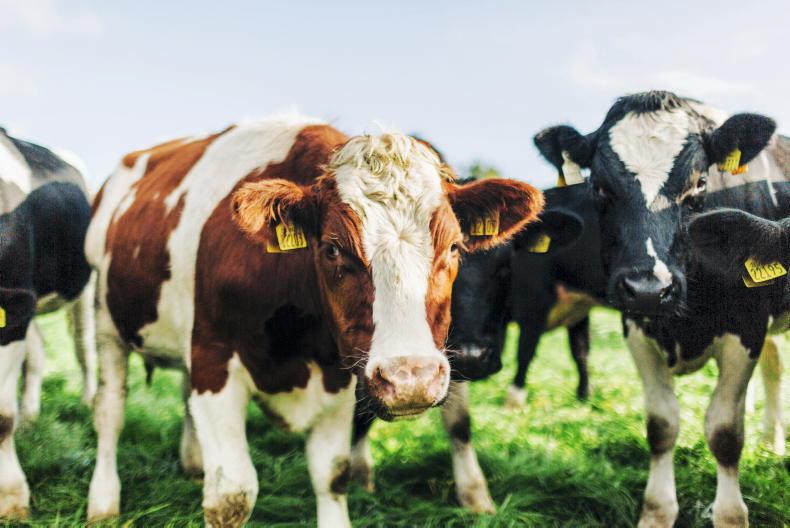Cutting livestock numbers and unprecedented levels of afforestation could be needed for the farming and land use sectors to meet climate goals, a report published by the Environmental Protection Agency (EPA) has claimed.
The EPA-led report stated that incentivising farm diversification is important, as reducing livestock numbers will “likely be necessary” to achieve and maintain the “deep emissions cuts” needed to meet targets.
A “managed reduction” of the national herd could help in “rebalancing land use” by opening up lands that are currently farmed to forestry, peatland rewetting and biodiversity, the report maintained.
It said that a drive to 25,000ha to 35,000ha of newly planted forestry will be needed each year for forests to contribute to net zero.
Higher economic breeding index (EBI), improved animal health and more efficient feeding strategies were all listed as being important in efforts to reduce emissions.
Methane-reducing feed additives and the use of protected urea were mentioned as among the new developments which still remain at the “early stages of implementation” in Irish agriculture.
The rollout of emissions-reducing technologies has been slowed by factors which include equipment costs and a lack of knowledge transfer, it was said.
Pathway unclear
Reporters stated that despite a recognition that carbon removal is important on the path to net zero, there remains a “critical gap in research” on the actual levels of emissions that can feasibly be “balanced with land use practice”.
The report insisted that current climate policy is “insufficient” to meet the legal basis already in place for achieving “deep, rapid and sustained national emissions cuts”.

The climate pathway for farmers is less clear than it is for those operating in other sectors of the economy, the report stated.
It added that the “pathway forward” for the energy, transport and construction sectors is “clearer” than it is for the farming and land use sectors.
It was also acknowledged that the economic, social and political dimensions of climate policy need to be considered.
Climate impact on farms
The report found that climate change will affect “all aspects of Irish agriculture”.
“While increases in productivity can be expected for some crops, decreases can be expected for others,” it stated.
The impact of pests and disease on crops and livestock will increase, with any potential for higher yields due to longer growing seasons at risk of being offset by more frequent and more severe droughts.
Water quality could also take a hit from increased levels of rainfall, as more nutrients are washed from land into waterways.
On the forestry impacts of climate change, it was determined that species including Scots pine, beech and birch will likely fare better than deciduous species.
The report was led by the EPA and funded primarily by the Department of the Environment.
Cutting livestock numbers and unprecedented levels of afforestation could be needed for the farming and land use sectors to meet climate goals, a report published by the Environmental Protection Agency (EPA) has claimed.
The EPA-led report stated that incentivising farm diversification is important, as reducing livestock numbers will “likely be necessary” to achieve and maintain the “deep emissions cuts” needed to meet targets.
A “managed reduction” of the national herd could help in “rebalancing land use” by opening up lands that are currently farmed to forestry, peatland rewetting and biodiversity, the report maintained.
It said that a drive to 25,000ha to 35,000ha of newly planted forestry will be needed each year for forests to contribute to net zero.
Higher economic breeding index (EBI), improved animal health and more efficient feeding strategies were all listed as being important in efforts to reduce emissions.
Methane-reducing feed additives and the use of protected urea were mentioned as among the new developments which still remain at the “early stages of implementation” in Irish agriculture.
The rollout of emissions-reducing technologies has been slowed by factors which include equipment costs and a lack of knowledge transfer, it was said.
Pathway unclear
Reporters stated that despite a recognition that carbon removal is important on the path to net zero, there remains a “critical gap in research” on the actual levels of emissions that can feasibly be “balanced with land use practice”.
The report insisted that current climate policy is “insufficient” to meet the legal basis already in place for achieving “deep, rapid and sustained national emissions cuts”.

The climate pathway for farmers is less clear than it is for those operating in other sectors of the economy, the report stated.
It added that the “pathway forward” for the energy, transport and construction sectors is “clearer” than it is for the farming and land use sectors.
It was also acknowledged that the economic, social and political dimensions of climate policy need to be considered.
Climate impact on farms
The report found that climate change will affect “all aspects of Irish agriculture”.
“While increases in productivity can be expected for some crops, decreases can be expected for others,” it stated.
The impact of pests and disease on crops and livestock will increase, with any potential for higher yields due to longer growing seasons at risk of being offset by more frequent and more severe droughts.
Water quality could also take a hit from increased levels of rainfall, as more nutrients are washed from land into waterways.
On the forestry impacts of climate change, it was determined that species including Scots pine, beech and birch will likely fare better than deciduous species.
The report was led by the EPA and funded primarily by the Department of the Environment.







 This is a subscriber-only article
This is a subscriber-only article











SHARING OPTIONS: